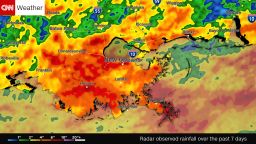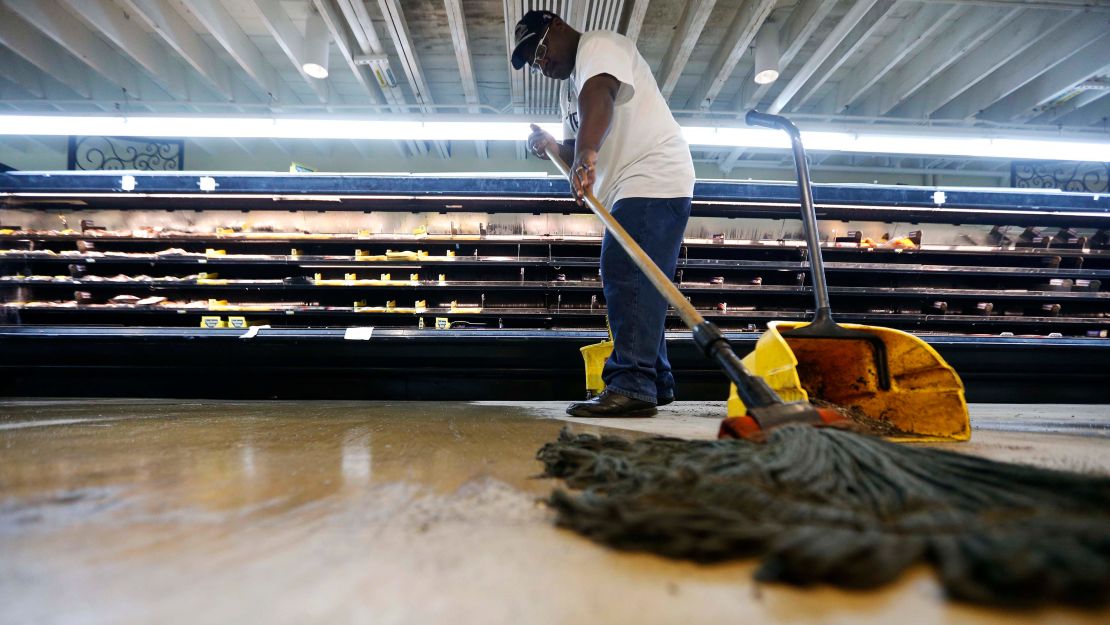Story highlights
Key officials asked to resign after critical drainage pumps didn't work, officials say
The problem highlights infrastructure challenges facing the nation, mayor tells CNN
New Orleans Mayor Mitch Landrieu has requested the resignations of four top officials, including the director and the top engineer at the municipal water utility, after a historic rainstorm flooded homes and exposed critical weaknesses in the city’s unique drainage pumping operation.
Meanwhile, with more heavy thunderstorms predicted through the weekend, property owners cleared damage from the deluge and braced for another potential onslaught.
The breakdown Saturday in the drainage system, which led to the flooding of “a couple hundred” properties, highlighted the challenges posed by New Orleans’ aging infrastructure – a problem mirrored in roads, bridges, water pipes and sewer plants across the nation, Landrieu told CNN.
“Because of the visuals of (Hurricane) Katrina, people keep thinking New Orleans is different than everybody else,” the mayor said. “It is absolutely true that the infrastructure in this country is crumbling at a scary pace, and what you just witnessed was infrastructure … that was unable to keep up with our threats.”
Flooding early this year in Houston and just this week in San Antonio offers proof New Orleans is not the only major city that faces a flood threat, Landrieu said. He drew a distinction between Saturday’s rain and 2005’s Hurricane Katrina, during which breaches in federal levees led to the flooding of some 200,000 properties.
Pumping out the water
Because of New Orleans’ unusual topography – with many areas below sea level – it takes about 100 pumps spread across every neighborhood to suck water out of storm drains and canals and push it into a nearby lake or other water bodies. The pumps vary in size and capacity; some are as big as a garage and more than a century old.

Saturday’s storms dropped several inches of rain in just a few hours in a handful of neighborhoods. In those places, six of the city’s most powerful pumps were offline for routine maintenance or because they’d broken down, said Ryan Berni, the deputy mayor of external affairs.
That meant the system’s capacity to drain those areas was cut nearly in half, causing rainwater to pile up like traffic behind a wreck – and ultimately causing it to push into homes, restaurants and offices, said Berni, whose own home sustained minor flooding.
“We just got really smacked in the wrong place at the wrong time,” Landrieu said.
Even so, Landrieu acknowledged that his city’s pumps are not all up to par, the result of limited federal funding and a tight local budget. Indeed, the six pumps that were unavailable Saturday – plus two similar ones in farther flung parts of the city – are still offline, said Berni, who did not know when they’d be back in action.
More problems, as storms loom
And in yet another setback, New Orleans’ Sewerage and Water Board lost service Wednesday night to one of its power turbines, which run the city’s oldest and most powerful drainage pumps. It reduced the system’s ability to drain street water on the east bank of New Orleans, where areas that flooded Saturday are located, the mayor said.
“The city is urging residents in the affected area to move their vehicles to higher ground, take necessary actions to protect personal property, and stay off of roadways during rainstorms unless an emergency makes it absolutely necessary to do so,” Landrieu said in a statement.
It was the latest example of repeated equipment failures that have led to boil-water advisories and similar flooding from heavy rain since the deadly 2005 flood.
“It’s a system that was broken before (Katrina) and that was more broken after,” said Landrieu, a Democrat who leads the US Conference of Mayors, which begins its summer meeting today in New Orleans. Plans are in the works for about $2 billion in repairs and improvements, Landrieu added, though the sum amounts to less than a quarter of what experts have said is needed.
“The amount of money they’re talking about isn’t going to come close to meeting the need, so the public can set their expectations, because you can’t have something for nothing,” the mayor said.
President Donald Trump has vowed to ask Congress to approve a $1 trillion infrastructure bill, a nod to his campaign pledge to rebuild the country’s physical foundation. The President so far has proposed $200 billion in tax cuts that the White House predicts would spur $1 trillion in infrastructure investment.
‘We have been told lies’
New Orleanians expect street flooding during storms. But even lifelong residents expressed confusion and frustration at the length of time water lingered on streets after Saturday’s deluge, especially when city leaders at first said the drainage system was “operating at its maximum capabilities,” CNN affiliate WDSU reported.
Anger boiled over during a five-hour hearing Tuesday, when some of those same city leaders admitted key pumps that serve flooded neighborhoods were broken.

“We have been told lies, and that’s the truth,” City Councilwoman LaToya Cantrell said, CNN affiliate WVUE reported. “We are so sick and tired of not being told what the facts are in order for us to create real solutions to address the infrastructure problems that we have in the city of New Orleans.”
Landrieu said he did not know before Saturday’s storms that drainage capacity was far below its maximum level in affected neighborhoods. That oversight, along with the misinformation his underlings initially shared, pushed him to demand they step down, he said.
“You cannot speak mistruths to the public because they can’t then protect themselves and then you can’t fix it for the future,” Landrieu said.
Pumps that drain rainwater from New Orleans’ streets are not the same pumps that the US Army Corps of Engineers built after Katrina as part of a $14 billion effort to fortify the city against tropical events.
The federal pumps are designed to mimic the city’s own rainwater pumping capacity when enormous gates at the mouths of key drainage canals close to stop storm surges from pushing Lake Pontchartrain back into neighborhoods. Those gates remained open Saturday.





